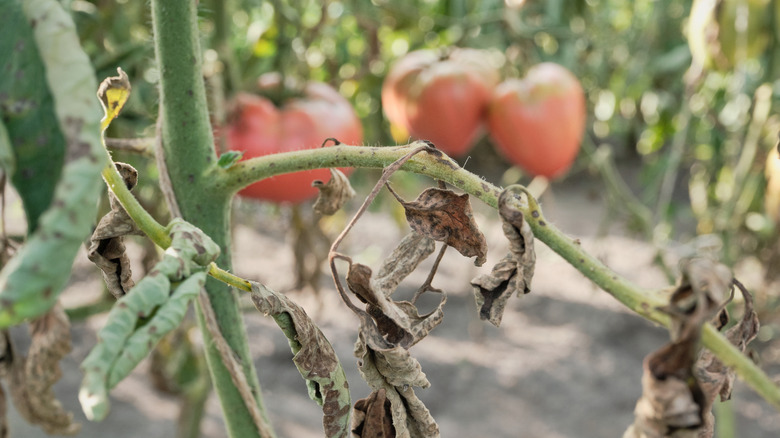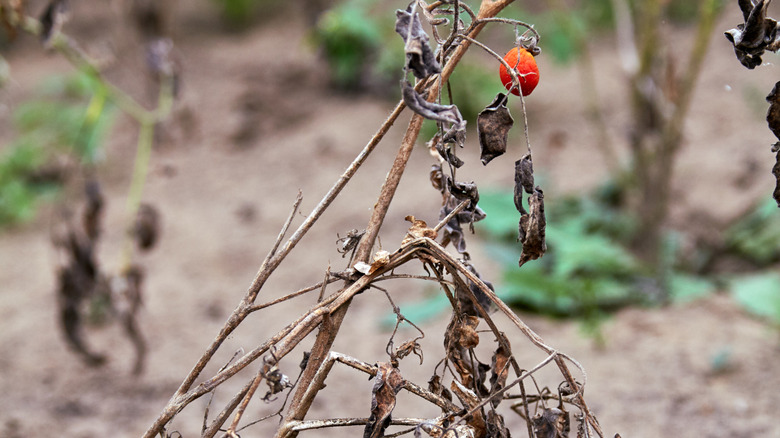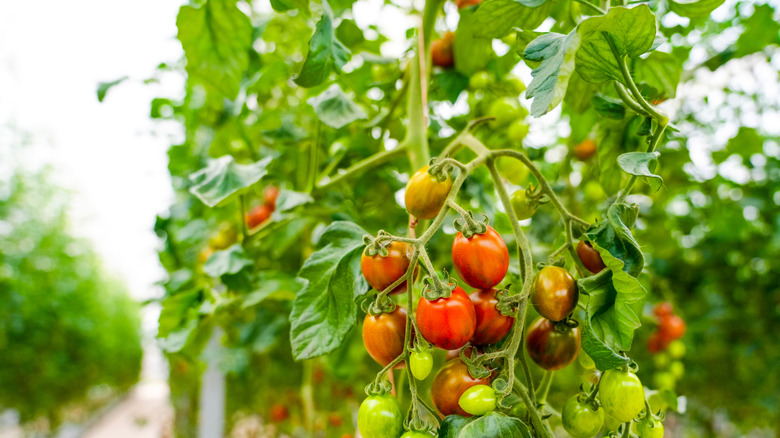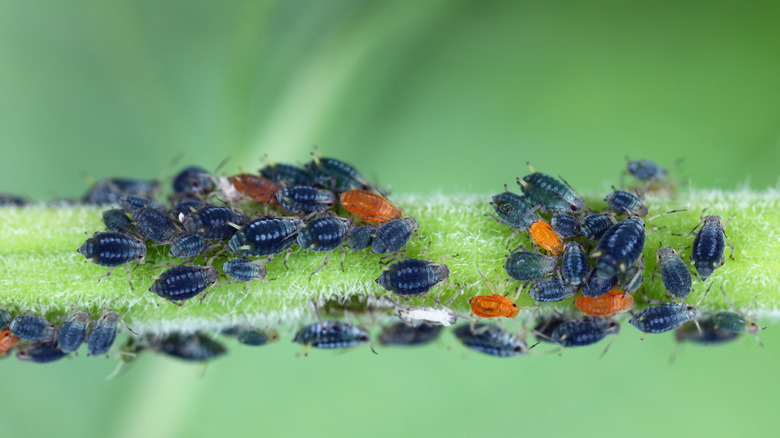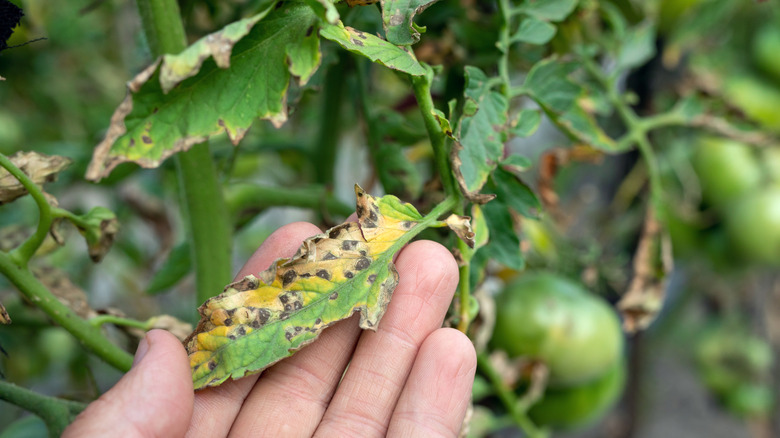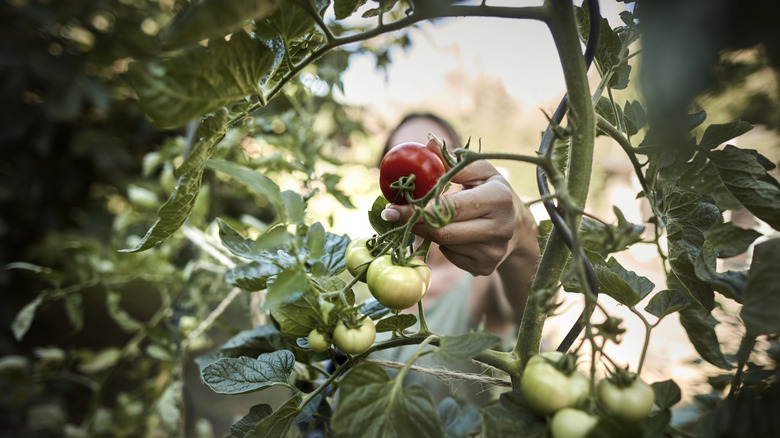Reasons Why Your Tomato Plant Has Curling Leaves And The Best Ways To Fix It
Your plants can be just as fickle, temperamental, and fragile as any other living entity under your care. While tomato plants usually fall under the "easy" category when it comes to maintenance, there are certain stressors that will negatively affect their health — and, by extension, your delicious harvests. Curling leaves on tomato plants are a significant sign that there is something amiss, and the plant is in distress.
There are numerous reasons why your plant's leaves could be curling. Some are tied to environmental factors, such as underwatering, overwatering, and excessive exposure to sunlight. Others include pests and diseases. Poor cultural practices, like improper pruning or herbicide applications could also cause the leaves to curl.
So, should you notice this phenomenon, your first task is to trace it back to the root cause and eliminate it as soon as possible. In some cases, you may be able to save your tomatoes, and the fruits of your labor will be worth the delicious treats you get when they ripen. In others, you may have no choice but to destroy the plants.
Your tomato plants may not be sufficiently hydrated
One of the main reasons your leaves will occur is due to dehydration or drought. If it is very hot where you live, your plants may be having trouble finding sufficient moisture. Transpiration is a process through which water evaporates from a plant's leaves, cooling it in the process. Extreme heat accelerates the process, and if the tomato plants' roots don't have access to enough water, they may curl their leaves to conserve as much moisture as possible.
If your tomatoes' leaves are curling in excessively hot conditions, during periods of drought, or when you've neglected irrigation for a while, it could mean that the plants need to be watered more heavily. To help your plants absorb water and to keep their soil sufficiently moist, try watering your tomatoes in the mornings or when it's cooler outside. You could also opt for drip irrigation system that's timed so you don't have to worry about doing it manually. Covering the bases of the plants with straw mulch helps keep the soil from getting too hot and drying out.
Too much sun can be detrimental to your tomato plants
Along with a lack of water, excessive sun exposure could also cause your tomato plants to curl their leaves. They do prefer direct sunlight and usually do well with at least six or more hours of it, but that doesn't mean that the UV rays aren't sometimes too intense for them. If you reside in a place where the UV index regularly soars above UV-8, too much direct sunlight might be detrimental to your plants. The curling leaves mean your tomatoes are trying to protect themselves from the excessive UV radiation; extreme sun exposure may even cause leaves to turn yellow or even die.
As an obvious cry for help, curling leaves are a sign that you need to provide some sort of shade when the sun is at its peak. Finding a location with enough, but not too much sun for tomatoes can be a problem, and is one of the downsides to growing tomatoes in your garden. However, shade cloths that offer 30% to 50% protection allow just enough UV rays to get to the tomatoes and support photosynthesis without harming the plants. Consider purchasing these shades for the warmer months, especially if you live in a region with intense sunshine.
Certain pests can lead to curling leaves
Curling leaves may also indicate the presence of insects. Almost every fruit and vegetable has a nemesis in bug form, and for tomato plants, the archenemy is aphids. These pests will bite and suck your tomatoes, damaging the leaves and causing stress to the plant. If aphids begin invading your garden, you'll likely notice leaves on the tomato plants curling, as these small bugs drain them of their moisture and nutrients.
You may not notice the aphids at first, but if you check underneath your plants' leaves, you will likely find scores of them — especially if there are no other issues, like excessive sun or dehydration. How you safeguard your tomatoes from pests like aphids comes down to preference, with options like attracting natural predators or using pest control solutions, though the latter is usually reserved for severe cases, as it can harm the good bugs, too. Instead of falling back on chemicals, you can try using an intense stream of water to wash the aphids away. Alternatively, spray them with a mixture made from dish soap and water. Certain companion plants, such as chives, can act as a natural pest repellent for your tomato plants, too.
Curling leaves could be the sign of a fungal infection
A different type of predator — one that's a little harder to spot — is fungal disease, which can infect your tomato plants through the soil and cause curling in the leaves. While there are a few different types of fungi you should be wary of, Fusarium and Verticillium wilt are the two to watch out for. They get into the plant's roots, impede the circulation of nutrients and moisture, and destroy the plant's tissue. These infections harm the overall health of your plant, and the pathogens behind them must be eradicated as quickly as possible.
If you suspect a fungal infection in your tomato plants, remove the plants completely, including the roots, from the soil. All plants that have become infected by these diseases should be destroyed this way to protect their still-healthy counterparts. Dispose of the tomato plants you've removed by throwing them away separately to keep the fungal spores from getting into compost piles. When you're done, clean any tools that have come into contact with the plant, or the soil around it, to avoid spreading the pathogens.
Overwatering, pruning, nutrients, and herbicides
A number of other causes can be behind your tomatoes' curling leaves. Like underwatering, overwatering is also a possible trigger, and drowning your tomato plant is not the ideal solution to combat lack of moisture. Tomato plants should get an average of one inch of water weekly, but this requirement can vary depending on the soil and the weather. See if the soil is dry before deciding if you need to add more water.
Along with this, pruning your plants excessively, planting your tomatoes too early, and providing too much nitrogen via fertilizer can all result in leaf deformation. Performing a soil test to check for the medium's nutrient composition can help you make informed decisions about which fertilizer to use.
It may not be one of the common reasons your tomato plant leaves are curling, but herbicide drift is one possible cause to keep in mind if you notice this issue and none of the above apply. Herbicide drift is when contaminants from herbicides are blown onto your tomato plants, or if the plants come into contact with manure that has been sprayed with certain herbicides. It may be tricky to control herbicide exposure, especially if you or your neighbors have applied treatments in the garden. The best you can do is ensure that these chemicals aren't sprayed too close to your tomatoes.
